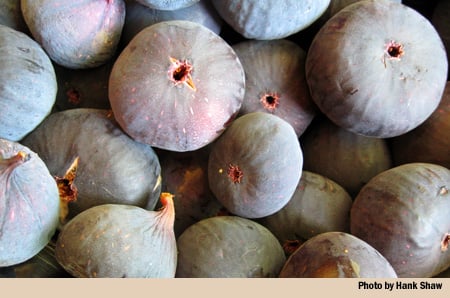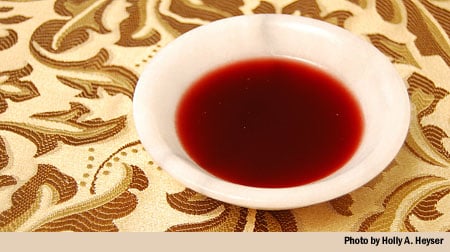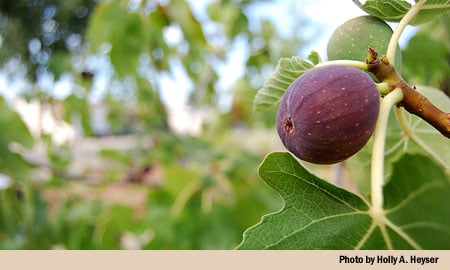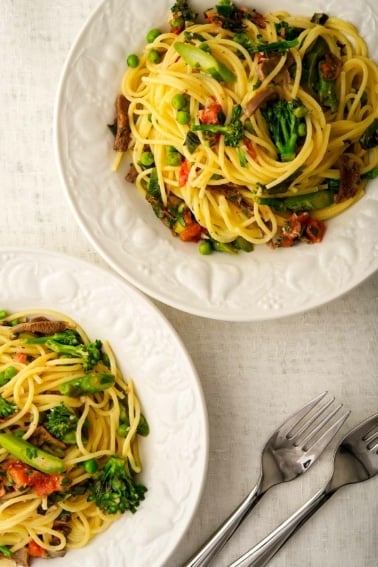As an Amazon Associate I earn from qualifying purchases.

I am awash in black Mission figs. I know, this is not the worst problem to have, and I am ready for the hate mail from my Northeastern and Canadian friends. But still. Our tree is five years old now and has been popping out figs since late June; only then it was a few at a time, perfect for fresh eating.
Now it’s a dozen or more at any given moment. Holly likes eating them fresh, and so do I on occasion, but because figs tend to lack that acidic tang blackberries, elderberries or really most any other fruit possess, a really ripe one feels like eating a blob of figgy sugar.

But that’s old hat now. So I thought about figs for a while, wondering what, in essence, is a fig all about? (Yeah, I know I’m a little crazy. Deal.) What I kept coming back to is that figgy blob of an overripe fig: It’s Nature’s jelly bag — pure sugar. A really ripe fig can hit a brix reading of 23-24, a sugar level powerful enough to make wine (hey, THAT’s an idea!), so why not just go with it?
I started with fig jam. This one is easy, and I like eating it. I make an odd fig jam, however, spiked with ouzo and cooked with bay leaves and a little salt. It makes a far more “adult” tasting sweet than typical recipes.
A few tips on making this: Chop your figs small enough so that the skins, which don’t break down completely, will be small enough so you can still spread the jam on toast. If you use it in a sweet-savory pan sauce (it would go well with venison or wild turkey), you also want everything chopped small so it looks good as a sauce.
Stir the bubbling figs often, or suffer the fate of burned figs on the bottom of your pot, which smell nasty, and can ruin a batch, not to mention your pot. This can happen very quickly once the water content of the jam is boiled down, so stay close.
I did not add any pectin to my jam, so it is pretty loose. I like it this way, but you could add pectin if you wanted. A final tip: Add some of the ouzo at the very end, so it retains some alcohol. Then feed it to your small children when they’re rambunctious. Calms ’em right down…
I thought about making fig ice cream or sorbet, am was still mulling this when our neighbor Aleika offered to make some for us. Sure, why not? She did, and while it’s good, fig sorbet remains a work in progress. She added some Port to the sorbet — great idea — but for some reason it was not overly figgy tasting. And then there was the problem of the seeds.
Let me say for the record that I loathe fig seeds. OK, that’s an overstatement, as I don’t mind them one bit when I eat a fresh or dried fig. But I don’t like the gritty feel of them in the sorbet, and I like them even less in fig syrup.
Oh yes, I made fig syrup. Looks beautiful, tastes wonderful, but it is an absolute ball-buster to make.
Let me start by saying I do not make a lot of jams and jellies. My elderberry jelly did not set, and as a rule I don’t eat a lot of sweet things. So maybe there is a better way to make this syrup, and if you know of one by all means fill me in, as the process I used to get to this lovely garnet syrup was no fun.
First part is easy. Chop figs and cook down for 2-3 hours with some water, lemon juice and lemon zest. Tastes great, and would make a good fig jam. But a proper syrup should not have seeds. Ever try to strain out fig seeds before? They’re smaller even than strawberry seeds. Grrrr…
I started by running everything through the fine plate on my food mill, which has been getting a lot of use these days. That separated the skins, some pulp, and a few seeds. Then I tried pushing the figs through a fine-mesh strainer lined with cheesecloth.
No dice. It was still way too thick, and it ruined the cheesecloth. Getting frustrated, I searched for my jelly bag. Oh yeah, that’s right, I don’t own a jelly bag. Sigh. I do own standard cotton undershirts, however, and so I cut out a big square of one and used that as my jelly bag.
Hanes did me proud. By squeezing and loosening the tension on the figgy mass, I got most of the good stuff out — and left those goddamn seeds in the shirt. Finally, I got out more cheesecloth and pushed the fig juice through a fine-mesh sieve.
Not done. I measured out the strained fig juice and added 2/3 its volume in sugar — normally a syrup ratio would be one-to-one, but figs are already sweet. I just eyeballed the ratio, and may have been able to go lower. Still working on it. I brought the syrup to a simmer and let it cook for 20 minutes to boil off some more water.
In the end, it was beautiful. But about five pounds of figs gave me two pints of syrup. Damn. The kicker? I have no idea what I am going to use this stuff in. I’m sure I can think of something, but I didn’t make fig syrup because I had a burning urge to make fig syrup. I did it to get rid of five pounds of figs.
Turns out you can buy an Italian version of fig syrup online. Who knew?
I went out to water my artichokes yesterday. They’re just now breaking dormancy and need a ton of water to grow fast if I want a crop by Thanksgiving. My artichokes live next to the fig tree, which I’d picked clean a few days’ prior so I could do all these figgy experiments. What did I see?
Sonofa… They just won’t stop. Don’t make me make fig syrup again, people. I need help with ideas to put up another zillion figs. Help!
MORE ON FIGS
- Simple Pleasures: Fresh Figs
- A recipe for sykomaitha, Greek fig cakes
- How to make fig jam
- Fig syrup recipe
___________







I love gfig jam and figs eaten right off the tree. Can I also put in a plug for Chicken with Figs and Raz el Hanout or a chicken tagine with figs or roasted figs with honey and goat cheese. Google these delights and they just might become faves.
Love all the ideas here! I too am happily swimming in a tsunami of black mission figs, I don’t want it to end! I hope I can successfully preserve some It’s not something in my wheelhouse. My contribution, I’ve been chopping a handful up into crepes with cream cheese walnuts and a drizzle of honey. Total sugar bomb! But so delicious!! A flower tortilla prepared the same way and allowed to steam is a brilliant lazy hack I’ve since chosen to employ. Happy sugar high
everyone
Hank what happened to the Greek fig cake recipe? Link does not appear to work (on iPhone). Thanks!
Funny I am attempting to make my great Aunts fig Cartellate cookies they required fig syrup. I found tiny bottles of fig syrup on Amazon not cheap. I am looking for a bigger bottles. Where can I get that?
This is my first time cooking figs. A friend of mine had too much that she had frozen from last year. There are a lot of little seeds after cooking them. Did i do something wrong?
Sally: No. Figs are full of little, edible seeds.
Fig brandy is awesome! I soaked dried calimyrna figs in brandy for a week, strained and poured over crushed ice (adult icee!). It’s like drinking candy. I have some fig vodka in the works now…
Skewered figs:
Slice figs almost in half and stuff with goat cheese. Wrap with prochutto and skewer onto twigs of rosemary, leaves removed. BBQ until cheese is soft. Yum!
I make a fig jam that is a combination of a few recipes. I add balsamic vinegar and a sachet of peppercorns, which gives it a really nice bold flavor profile. I love the idea of using ouzo in the jam, maybe I’ll give that a try this year! My deluge of figs should be coming in the next few weeks…
Just spitballing here, but I’m wondering about the chemical comp of the skins and seeds. Is there any reaction other than sustained heat that would break down the seed hull to make it less intrusive? What about sous vide? I have a violent itching reaction to figs (sap and leaves make me want to scratch off my skin), so largely gave them up, but have had good success with long slow cooking, which is what gave me the sous vide idea.
As far as the syrup goes: take a look at Christine Feber’s book on jam (Mes Confitures, available from Amazon). She uses multi-day techniques which soak fruits in sugar (with quick heat/cool cycles) to yield jams and jellies. Might be worth experimenting.
I would suggest sharing with your neighbors. I live in California and we just planted a new fig tree early this year. We have just a handful of figs, not enough to satisfy our love of figs. I have a few neighbors in the area that have some trees and I have knocked on a few doors to see if they will sell me some figs. The response is always “please take as many as you want” at no charge. So find some neighbors that like them and share. One of the neighbors that shares figs with me also takes them to the nearest food bank. Today I’m baking fig muffins. Yumm!!!!
I am sure that you all have tried the recipe adding strawberry jello to the jelly mix. It is hard to tell them from strawberry jelly then!!
I like the savory with sweet conceits — fig preserves as a glaze for duck — fig halves broiled with a topping of caramelized onion, bacon, thyme, goat cheese. So delicious. But your figs are probably all gone by now!
I second the fig preserves idea. We use to make this at my aunt’s house every summer. Fantastic spooned over some vanilla ice cream! Also, I once came across a goat’s milk cheese stuffed fig recipe online that looked mouthwateringly enticing.
Glad you’re getting a good crop! My mother and grandfather both have fig trees (over on the east coast) that haven’t borne much at all the last year or two I think due to a combination of bugs and hellish summer.
Generally I just eat them fresh or broil halved figs with a dab of brie or mild blue on top. I’d be inclined to try fig wine if I had enough fruit-in my time working in homebrewing one of my customers made a batch a few years going, (but never coughed up a sample)
I love the sound of your fig jam, I hate overly sweet jams. Try my balsamic pickled figs w walnuts. They are brilliant w meat. https://www.putsup.com/2009/08/balsamic-pickled-figs.html. YUM YUM